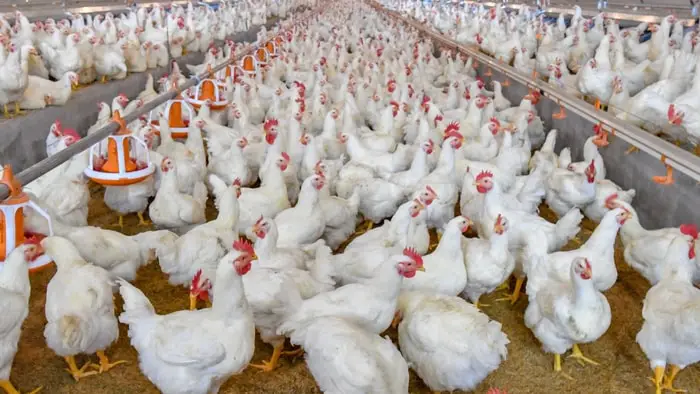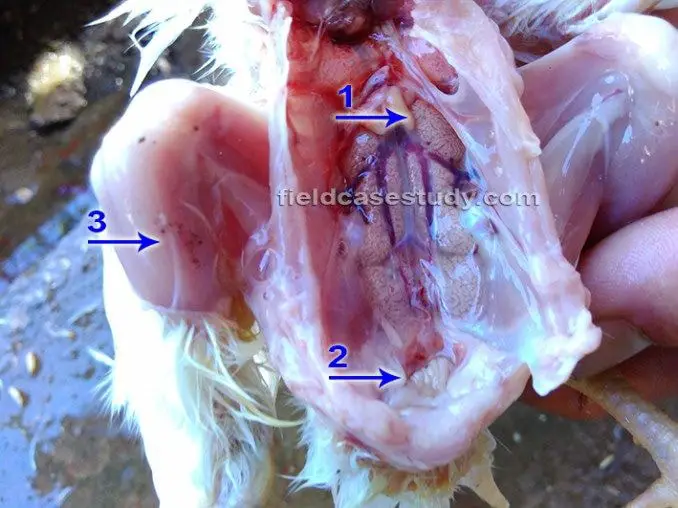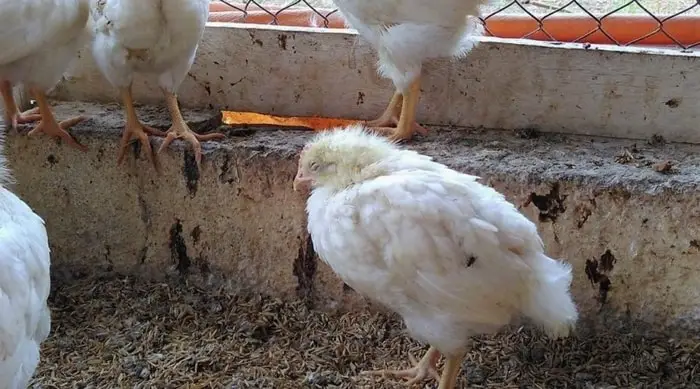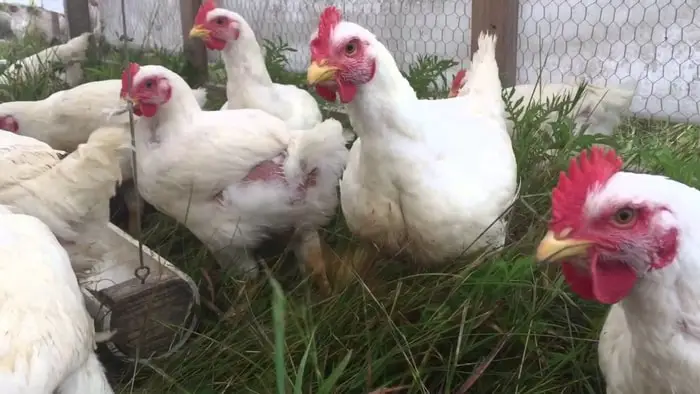Gumboro or Infectious bursal disease (IBD) is an acute, highly contagious immunosuppressive disease of chicken. IBD is characterized by the destruction of lymphoid cells in the Bursa of Fabricius and other chicken lymphoid organs. The disease has also been reported to occur in turkeys and ducks. Chicken of 3-6 weeks of age is mostly affected, although the disease may occur in chickens of 2-15 weeks of age and below two weeks of age.
Important Information on Gumboro Disease in Poultry
The infectious bursal disease was first discovered on the farm in ‘Gumboro district’ of Delaware, the USA, in 1962, from where the name Gumboro was derived. Initially, the Gumboro disease was confused with a variant form of Infectious bronchitis virus accompanied by nephrosis. In my article, I shall discuss the essential information on IBD.

Causes of Infectious Bursal Disease (IBD)
Infectious bursal disease virus ( IBDV ) is a double-stranded RNA virus with a bi-segmented genome and belongs to the genus Avibirnavirus of the family Birnaviridae. Two serotypes (serotypes 1 and 2) of IBDV are found. However, the clinical disease is caused by serotype one only.
Epidemiology and Transmission of Gumboro Disease
The Gumboro outbreaks have been reported in chickens aged between 3 to 10 weeks, 2 to 16 months, 2 to 5 weeks, and 19 to 22 days. The disease is distributed worldwide. Although ducks, goose, turkeys, guinea fowl, and ostriches may be affected, the disease occurs solely in chickens. The white leghorns are more susceptible than broilers and other breeds.
Transmission of the disease usually occurs through contaminated feed, water, and litter. However, direct contact of young birds with infected flocks in multi-aged units may result in persistent ‘rolling’ infection. Indirect infection with IBD may also occur as the agent can survive in the environment for up to 3 months.

Pathogenesis of the IBD
Following entry by the oral or respiratory route, the virus replicates in gut-associated macrophages and lymphoid cells. They then spread to different organs, especially to the bursa via the portal vein and primary bloodstream. Rapid multiplication of virus in the bursa occurs that reaches high concentration, leading to a fatal outcome in most cases. The virus exerts lymphocidal action and thus adversely affects the immune system, resulting in severe, long-lasting immunosuppression.
Pathological Lesions of The Infectious Bursal Disease
- Hemorrhage in the thigh and/or breast muscle and occasionally in the mucosa at the proventriculus’ junction.
- Increased mucus in the gastrointestinal tract.
- Kidney swollen and hemorrhagic.
- Bursa swollen, hemorrhagic, edematous with cream-colored.
- Caseous mass followed by atrophy within 6-8 days post-infection.
- There may be extensive bleeding from the bursa, and birds may void blood in the feces.
- The spleen may become slightly enlarged with small gray foci scattered on its surface.

What are the Symptoms of Gumboro Diseases?
Incubation periods range from 2-3 days, and birds may suffer from either clinical or subclinical infection. The symptoms may include-
- There is acute onset of depression, and the birds sit quietly with closed eyes and ruffled feathers.
- Affected birds peck at their vents and pericloacal feathers are stained with urates.
- There is whitish or watery diarrhea.
- Feed intake is reduced, but water consumption may be elevated.
- At terminal stages, birds may show sternal or lateral recumbency with coarse tremor or shivering, and finally death.
- Infected birds show variable morbidity 5-100%, and mortality rate may range from 20-90%.
- The birds may recover in a week, but the reduction of antibody levels makes the birds more prone to other infections.
- In subclinical infection, the symptoms are less pronounced, and the birds of less than three weeks of age remain dull and depressed.

Diagnosis of Infectious Bursal Disease
Diagnosis is based on evaluating the clinical sign and gross lesions that change in cloacal bursa and changes in skeletal muscles. This is followed by microscopic examination of the lymphocytes in the bursa for depletion in the follicle and dehydration of skeletal muscles with numerous ecchymotic hemorrhages, thigh, and pectoral muscles. Confirmatory diagnosis is performed by your veterinarians, which is isolation and identification of the virus, detection of virus antigen by immunofluorescence antibody technique, and detection of antibody by serum neutralization test, agar get diffusion test, and ELISA.
Differential Diagnosis of Gumboro Disease in Poultry
The disease may be confused with:
- Coccidiosis.
- Newcastle disease.
- Hemorrhagic syndrome.
How Do You Treat Gumboro Disease?
There is no specific treatment for the Gumboro due to virus etiology. A supportive measure such as increasing heat, ventilation, and water consumption is beneficial for your birds. Vitamin, electrolyte and facilitating access to water therapy is helpful. Antibiotic medication may be indicated if the secondary bacterial infection occurs.

Prevention and Control of IBD in Poultry
In preventing disease outbreaks, you should consider the maintenance of a high level of biosecurity with particular reference to the movement of personnel (manager, worker, seller, and buyer), feed (during collection), and vehicles are of great importance. Farms to be operated on ‘all in all out’ cycle and maintained an acceptable distance between units to prevent cross-contamination. Sero-monitoring of antibody level to measure the efficacy of the vaccination program has to be ensured.
It is necessary to maintain a high and uniform level of maternally derived antibodies in commercial chickens and maintain healthy parent stock for healthy offspring. The principal method of control is to maintain through the vaccination programs.
What is the Gumboro Vaccine?
Both killed, and live-attenuated vaccines are available to control the Gumboro disease. A live recombinant vaccine expressing the VP2 antigen of IBDV has also been licensed recently elsewhere.
Key Points on Infectious Bursal Disease (IBD)
- Gumboro or Infectious bursal disease is a viral disease that is caused by the Infectious bursal disease virus.
- It is a contagious viral disease of young chickens.
- The disease is distributed worldwide and characterized by diarrhea, vent picking, trembling, incoordination, inflammation, followed by atrophy of the bursa Fabricius and by variable degrees of immunosuppression and mortality generally at 3 to 6 weeks age.
- The diagnosis depends on the evaluation of the cloacal bursa and molecular identification of the viral genome.
- Effective prevention and control must involve a biosecurity program, an effective breeder vaccination program, and an effective broiler and pullet vaccination program.